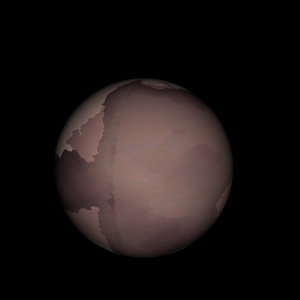|
|
Space Astro
|
Info for exoplanet "Nyuri Cha"
| Scientific (actual) data |
|---|
| Planet | HIP 89474 b |
| Planet status | Confirmed |
| Mass sini | 0.0299 |
| Orbital period | 15.1479 |
| Semi major axis | 0.1192 |
| Orbit eccentricity | 0.121 |
| Discovered | 2021 |
| Updated | 2021-05-31 |
| Omega | 13 |
| Tconj | 2455200 |
| Publication | Published in a refereed paper |
| Detection type | Radial Velocity |
| Mass detection type | Radial Velocity |
| Alternate names | HD 168009 b |
| Star name | HIP 89474 |
| Right ascension | 273.88° |
| Declination | 45.21° |
| Star mass | 0.98 |
| Star sp type | G1V |
| Star alternate names | HD 168009 |
| Wikipedia article | HIP 89474 b |
Back
| |
| Fictional info (?) |
|---|
| Suggested name | Nyuri Cha |
| Planet type | Cold planet |
| It is a cold planet planet with a mass one-thousandth that of HIP 89474, but two-and-a-half times that of all the other planets in its solar system combined. It is the coldest planetary atmosphere in its solar system, with a minimum temperature of 75°K (-198°C), and has a complex, layered cloud structure with water thought to make up the lowest clouds, and methane the uppermost layer of clouds. It is named after the deity Nyuri Cha, the bringer of love and beauty.
When viewed from Kuacho Shosu, this proximity to HIP 89474 means the planet can only be seen near the western or eastern horizon during the early evening or early morning. The planet telescopically displays the complete range of phases, similar to Venus and the Moon, as it moves in its inner orbit relative to HIP 89474, which reoccurs over the so-called synodic period approximately every 116 days.
An observer on Nyuri Cha would therefore see only one day every four years.
Nyuri Cha's axis has the smallest tilt of any of its solar system's planets.
Nyuri Cha is primarily composed of methane with a significant part of its mass being water, though water comprises only about a small amount of the number of molecules.
This scary place is known for its small stone-age humanoids that survive close to volcanos by seeking the Shabya. They are similar to the Gabinu but with 2 eyes and vary in length from 12 to 17 mm. Nenubu are able to endure temperatures from -30 to 0°C and predators attacking which is rare on this planet. |
| Estimated population | 8000 |
| Atmosphere | Methane | 74% |
| Water | 10% |
| Carbon dioxide | 9.4% |
| Oxygen | 6.3% |
| Atmospheric pressure | 0.04 bar |
 |
| No known satellites |
| Google search for Nyuri cha |
|
Website by Joachim Michaelis
|
|
|
|